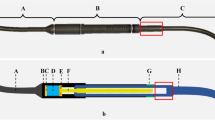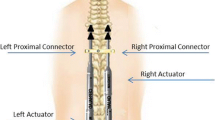Abstract
Purpose
Determine the incidence of metallosis around MAGEC rods.
Methods
A multicentre explant database was searched to identify cases with complete intraoperative findings at rod removal. Surgeons removing rods detailed the presence or absence of tissue metallosis associated with rods. More recently surgeons measured the ‘length’ of tissue metallosis. Prior to rod disassembly, the majority underwent testing with an external remote controller (ERC). The impact of clinical and explant variables on metallosis was assessed.
Results
Sixty-six cases were identified. Mean age at insertion was 8.1 ± 2.3 years with mean duration of implantation 37.6 ± 15.1 months.
Tissue metallosis was noted at revision surgery in 52/66 cases (79%). Metallosis was noted more commonly when rods were removed during fusion surgery than rod removal/exchange (97% vs. 58% (p = < 0.01)). The mass at insertion was greater in cases with metallosis (25.9 ± 7.8 kg vs. 21.1 ± 6.2 kg, p = 0.04).
Length of tissue metallosis was reported for 45 rods, median 9 cm (range 1–25). Metallosis was noted in 43/59 (73%) rods that produced no force and 22/30 (73%) rods that produced some force on ERC activation (p = 0.96). Wear debris was found within the actuator in all rods, and all but 3 rods had damaged O-rings.
Conclusion
MAGEC rods are associated with tissue metallosis in the majority of cases. It is seen with functional rods as well as failed rods and appears related to wear debris within the actuator and high rates of O-ring failure. Until the implications of metal debris in children are known, we urge caution with the use of this implant.


Similar content being viewed by others
References
Cheung KM-C, Cheung JP-Y, Samartzis D et al (2012) Magnetically controlled growing rods for severe spinal curvature in young children: a prospective case series. Lancet 379:1967–1974
Nnadi C, Thakar C, Wilson-MacDonald J et al (2018) An NIHR-approved two-year observational study on magnetically controlled growth rods in the treatment of early onset scoliosis. Bone Jt J 100-B:507–515
NuVasive Urgent Field Safety Notice / MAGEC System. 2019.
MHRA MDA/2020/010 Spinal implant: MAGEC System Model X rods—risk of failure in use. 2020.
MHRA MDA/2020/011 Spinal implant: All MAGEC Systems—supply suspended to the UK. 2020.
Jones CS, Stokes OM, Patel SB et al (2016) Actuator pin fracture in magnetically controlled growing rods: two cases. Spine J 16:e287–e291
Teoh KH, von Ruhland C, Evans SL et al (2016) Metallosis following implantation of magnetically controlled growing rods in the treatment of scoliosis: a case series. Bone Jt J 98-B:1662–1667
Willis-Owen CA, Keene GC, Oakeshott RD (2011) Early metallosis-related failure after total knee replacement: a report of 15 cases. J Bone Jt Surg Br 93-B:205–209
Studer D, Heidt C, Büchler P et al (2019) Treatment of early onset spinal deformities with magnetically controlled growing rods: a single centre experience of 30 cases. J Child Orthop 13:196–205
Cheung JPY, Cheung KM (2019) Current status of the magnetically controlled growing rod in treatment of early-onset scoliosis: what we know after a decade of experience. J Orthop Surg 27:2309499019886945
Hosseini P, Pawelek J, Mundis GM et al (2016) Magnetically controlled growing rods for early-onset scoliosis: a multicenter study of 23 cases with minimum 2 years follow-up. Spine 41:1456–1462
Lampe LP, Schulze Bövingloh A, Gosheger G et al (2019) Magnetically controlled growing rods in treatment of early-onset scoliosis: a single center study with a minimum of 2-year-follow up and preliminary results after converting surgery. Spine 44:1201–1210
Subramanian T, Ahmad A, Mardare DM et al (2018) A six-year observational study of 31 children with early-onset scoliosis treated using magnetically controlled growing rods with a minimum follow-up of two years. Bone Jt J 100-B:1187–1200
Joyce TJ, Smith SL, Rushton PRP et al (2018) Analysis of explanted magnetically controlled growing rods from seven UK Spinal Centers. Spine 43:E16–E22
Rushton PRP, Smith SL, Forbes L et al (2019) Force testing of explanted magnetically controlled growing rods. Spine 44:233–239
Zhang TZ, Sze KY, Peng Z et al (2020) Systematic investigation of metallosis associated with magnetically controlled growing rod implantation for early-onset scoliosis. Bone Jt J 102-B:1375–1383
Cheung JPY, Yiu K, Kwan K et al (2018) Mean 6-year follow-up of magnetically controlled growing rod patients with early onset scoliosis: a glimpse of what happens to graduates. Neurosurgery 84:1112–1123
Tudor-Locke C, Craig CL, Beets MW et al (2011) How many steps/day are enough? for children and adolescents. Int J Behav Nutr Phys Act 8:78–78
Hallab NJ, Cunningham BW, Jacobs JJ (2003) Spinal implant debris-induced osteolysis. Spine 28:S125–S138
Daley B, Doherty AT, Fairman B et al (2004) Wear debris from hip or knee replacements causes chromosomal damage in human cells in tissue culture. J Bone Jt Surg, Br Vol 86-B:598–606
Igbokwe IO, Igwenagu E, Igbokwe NA (2019) Aluminium toxicosis: a review of toxic actions and effects. Interdiscip Toxicol 12:45–70
Fatola OI, Olaolorun FA, Olopade FE et al (2019) Trends in vanadium neurotoxicity. Brain Res Bull 145:75–80
Yilgor C, Efendiyev A, Akbiyik F et al (2018) Metal Ion release during growth-friendly instrumentation for early-onset scoliosis: a preliminary study. Spine Deform 6:48–53
Yang C-C, Tang C-L, Tzeng C-Y et al (2018) Metallosis after traumatic loosening of Bryan cervical disc arthroplasty: a case report and literature review. Eur Spine J 27:415–420
Goldenberg Y, Tee JW, Salinas-La Rosa CM et al (2016) Spinal metallosis: a systematic review. Eur Spine J 25:1467–1473
Wang JC, Yu WD, Sandhu HS et al (1999) Metal debris from titanium spinal implants. Spine 24:899–903
Singh V, Simpson J, Rawlinson J et al (2013) Growth guidance system for early-onset scoliosis: comparison of experimental and retrieval wear. Spine 38:1546–1553
Lukina E, Kollerov M, Meswania J et al (2015) Analysis of retrieved growth guidance sliding LSZ-4D Devices for early onset scoliosis and investigation of the use of nitinol rods for this system. Spine 40:17–24
McCarthy RE, McCullough FL (2015) Shilla growth guidance for early-onset scoliosis: results after a minimum of five years of follow-up. JBJS 97:1578–1584
Hill G, Nagaraja S, Akbarnia BA et al (2017) Retrieval and clinical analysis of distraction-based dual growing rod constructs for early-onset scoliosis. Spine J 17:1506–1518
Akazawa T, Minami S, Takahashi K et al (2005) Corrosion of spinal implants retrieved from patients with scoliosis. J Orthop Sci 10:200–205
Bellinger DC, Calderon J (2019) Neurotoxicity of general anesthetics in children: evidence and uncertainties. Curr Opin Pediatr 31:267–273
Acknowledgements
The authors wish to thank the surgeons contributing cases to this study from Bristol, Belfast, Edinburgh, Exeter, Leeds, Oxford and Sheffield in the UK, Aarhus in Denmark, Basel in Switzerland and Vancouver in Canada. We thank the manufacturers of the implant, NuVasive Specialised Orthopaedics, San Diego, CA, who kindly provided a testing jig but did not influence the conduct of this independent study.
Funding
No funding was received to assist with the preparation of this manuscript.
Author information
Authors and Affiliations
Contributions
Gibson MJ and Joyce TJ helped in conceptualization; Rushton PR, Joyce TJ, Smith S contributed to methodology; Rushton PR, Joyce TJ, Smith SL formally analyzed and investigated the study; Rushton PR, Joyce TJ helped in writing—original draft preparation; Gibson MJ, Fender D, Bowey AJ helped in writing—review and editing.
Corresponding author
Ethics declarations
Conflict of interest
The authors have no relevant financial or non-financial interests to disclose.
Ethical approval
This is an observational study.
Additional information
Publisher's Note
Springer Nature remains neutral with regard to jurisdictional claims in published maps and institutional affiliations.
Michael J. Gibson: Consultant Orthopaedic Spinal Surgeon (Retired).
Rights and permissions
About this article
Cite this article
Rushton, P.R.P., Smith, S.L., Fender, D. et al. Metallosis is commonly associated with magnetically controlled growing rods; results from an independent multicentre explant database. Eur Spine J 30, 1905–1911 (2021). https://doi.org/10.1007/s00586-021-06750-2
Received:
Revised:
Accepted:
Published:
Issue Date:
DOI: https://doi.org/10.1007/s00586-021-06750-2




